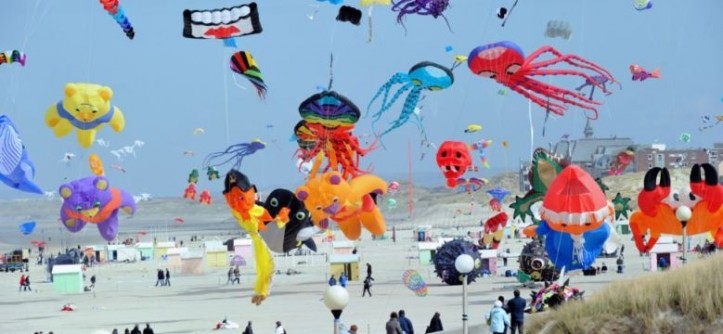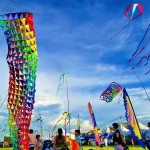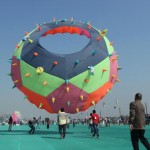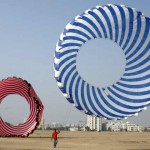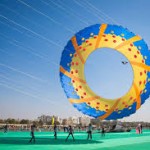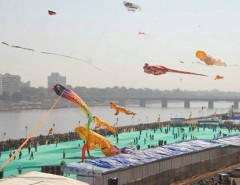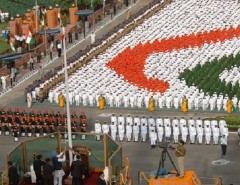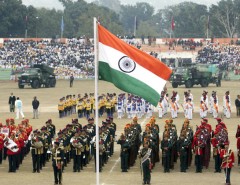Every year, Gujarat celebrates more than 200 festivals. The International Kite Festival (Uttarayan) is regarded as one of the biggest festivals celebrated. Months before the festival, homes in Gujarat begin to manufacture kites for the festival.
The festival of Uttarayan marks the day when winter begins to turn into summer, according to the Indian calendar. It is the sign for farmers that the sun is back and that harvest season is approaching which is called Makara Sankranti. This day is considered to be one of the most important harvest day in India. Many cities in Gujarat organize kite competition between their citizens where the people all compete with each other. In this region of Gujarat and many other states, Uttarayan is such a huge celebration that it has become a public holiday in India for two days. During the festival, local food such as Undhiyu (a mixed vegetable including yam and beans), sesame seed brittle and Jalebi is served to the crowds. Days before the festival, the market is filled with participants buying their supplies. In 2012, the Tourism Corporation of Gujarat mentioned that the International Kite Festival in Gujarat was attempting to enter the Guinness World Records book due to the participation of 42 countries in it that year.
Location
The International Kite Festival takes place in Gujarat India. The festival is called Uttarayan. The festival is celebrated in many cities of Gujarat, Telangana and Rajasthan like Ahmedabad, Jaipur, Udaipur,Jodhpur, Surat, Vadodara, Rajkot, Hyderabad, Nadiad. However, the International Kite Event takes place in Ahmedabad (Kite capital of Gujarat) which accommodates visitors from many international destinations. The best place to enjoy this festival is the Sabarmati Riverfront (its sabarmati river bank with capacity of over 500,000 people) or the Ahmedabad Police Stadium, where people lay down to see the sky filled with thousands of kites
During the festival week the markets are flooded with kite buyers and sellers. In the heart of Ahmedabad, there is one of the most famous Kite markets – Patang Bazaar, which during the festive week opens 24 hours a day with buyers and sellers negotiating and buying in bulk. Moreover, many families in Ahmadabad start making kites at home and setup small shops in their own homes.
There is also a Kite Museum, which is located at Sanskar Kendra in Paldi area of Ahmedabad. It was established in 1985, which has a numerous collection of unique kites. However, in Delhi and other parts of India also celebrates Kite festival. In Delhi 15 August and in Bihar’s most of the districts 14 April. It is said because they just prepare new crop wheat. People are offer pray, eat Sattu (made from new crop wheat) and new mangoes (baby mango also known as Tikola). People use to worship with Aam ka Pallo.
Dates
The festival takes place on 14 January of each year during the Makar Sankranti and continues until 15 January. This date marks the end of winter and the return of a more clement weather for farmers of the Gujarat region. These days have also become a public holiday within the Gujarat state of India so that everyone can take part in the celebration.
History
The symbolism of this festival is to show the awakening of the Gods from their deep sleep. Through India’s history, it is said that India created the tradition of kite flying due to the kings and Royalties later followed by Nawabs who found the sport entertaining and as a way to display their skills and power. It began as being a sport for kings, but over time, as the sport became popular, it began to reach the masses. Kite flying has been a regional event in Gujarat for several years. However the first International Festival was celebrated in 1989 when people from all across the globe participated and showcased their innovative kites. In the recent 2012 event, The International Kite Festival was inaugurated by Prime Minister Narendra Modi in the presence of Governor Dr. Kamla.
Participants
Although the idea of flying kites to celebrate Uttrayan was introduced by Muslims from Persia, today regardless of your background or beliefs, you are welcome to fly kites with everyone else in Gujarat in January. Most visitors arrive from around India, from Gujarat itself or another state. In major cities of Gujarat, kite flying starts as early as 5 am and goes until late night where approximately 8-10 million people participate in the whole festival.
However, many visitors are international who come from around the world, such as Japan, Italy, UK, Canada, Brazil, Indonesia, Australia, the USA, Malaysia, Singapore, France, China, and many more to take part in the celebration
The kite festival has been strongly influenced by its international participants, in the recent events, for instance:
- Malaysia brought wau-balang kites
- Indonesia brought llayang-llayanghave
- USA brought giant banner kites
- Japan brought Rokkaku fighting kites
- Italy brought Italian sculptural kites
- Chinese brought Flying Dragon kites
- For other kites, see list of Kite types
At the same time, the festival is the occasion for many public entities such as famous dancers, singers, actors or politicians who make an appearance and entertain the population. In 2004, for example, the Bollywood actress Juhi Chawla was part of the celebration and performed a Garba (dance) which is very popular in India.
Types of kites
During the event, kite markets are set up alongside food stalls and performers. The kites are usually made with materials such as plastic, leaves, wood, metal, nylon and other scrap materials but the ones for Uttarayan are made of light-weight paper and bamboo and are mostly rhombus shaped with central spine and a single bow. Dye and paint are also added to increase the glamour of the kite. The lines are covered with mixtures of glue and ground glass which when dried, rolled up and attached to the rear, also known as firkees, become sharp enough to cut skin. These types of sharp lines are used on fighter kites known in India as patangs to cut down other kites during various kite fighting events. During the night, on the second day of the festival, illuminated kites filled with lights and candles known as tukals or tukkals are launched creating a spectacle in the dark sky.
List of Other Kite Festivals
Kites are a real part of the culture in Asia, which is why most of the kite festivals around the world take place in those areas. Here are the Most Popular Kites Festival of the World:
- Japan Kite Festival in Uchinada, Ishikawa
- China Kite Festival called Weifang International Kite Festival
- Jakarta Kite Festival in Pangandaran
- Washington D.C. International Kite Festival formerly called Smithsonian Kite Festival, and now known as The Blossom Kite Festival
- Indonesia Kite Festival in Bali island, Bali Kite Festival
- United-Kingdom Kite Festival in Bristol city, Bristol International Kite Festival

